Meta Smart Glasses Live Translation Overview
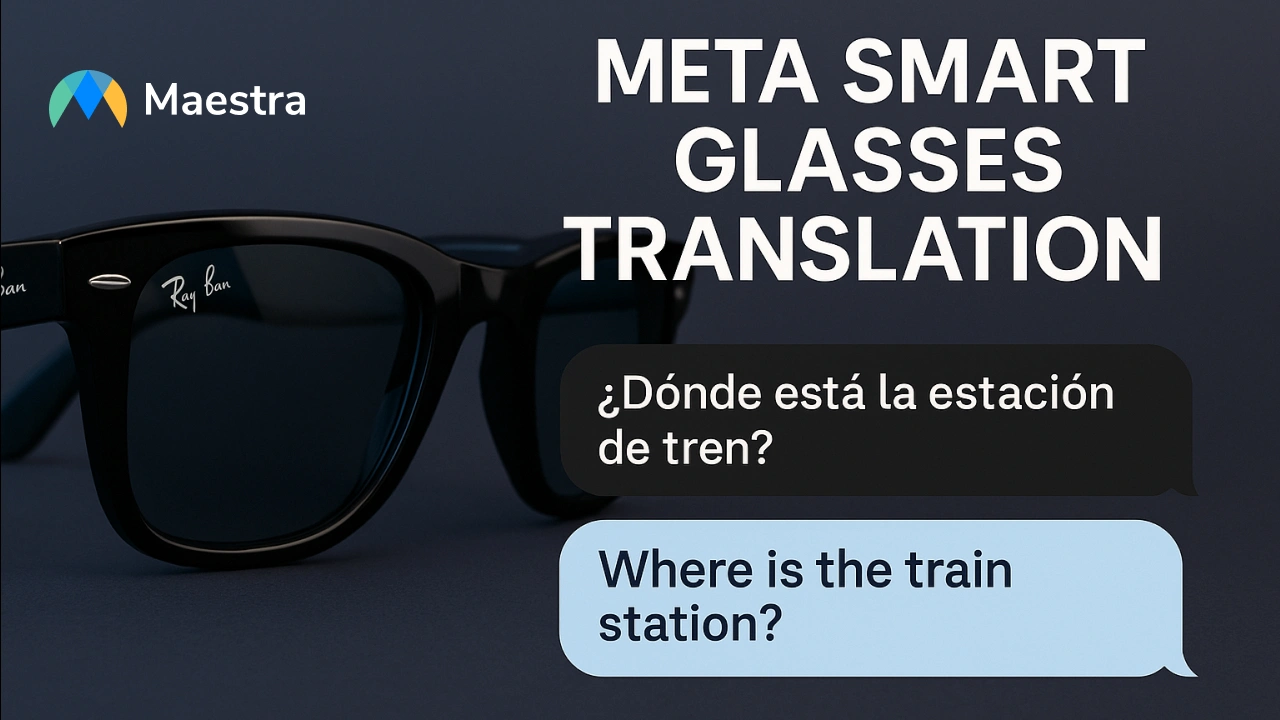
For decades, science fiction promised us technology that could erase language barriers with the push of a button. From Star Trek’s Universal Translator to the Babel Fish in The Hitchhiker’s Guide to the Galaxy, the dream has been simple: speak in your own language and be instantly understood anywhere on Earth.
With the latest update to the Ray-Ban Meta smart glasses, that vision is edging closer to reality. Meta’s new live translation feature, rolled out globally in April 2025, allows wearers to translate conversations in real time. The question is: how well does it work?
How to Use Translation on Meta Smart Glasses
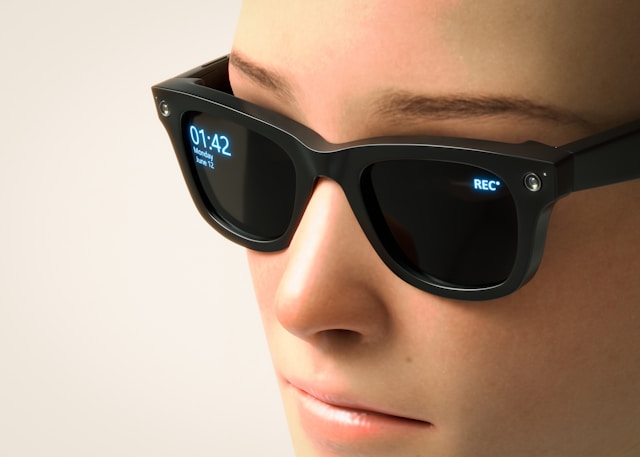
Using live translation on the glasses is fairly simple once everything is set up. According to Meta’s official guidance:
- Open the Meta View app on your phone and pair it with your Ray-Ban Meta glasses.
- Download the language packs you’ll need (currently English, Spanish, French, and Italian). This also enables offline translations.
- Activate translation by saying “Hey Meta, translate” followed by the target language, or by using the translation shortcut in the Meta View app.
- Speak naturally into the glasses. The microphones pick up your voice, process it, and play the translation through the built-in speakers.
- Listen to the reply in your own language. If the other person speaks one of the supported languages, the glasses will translate back for you.
Reviewers noted that voice activation doesn’t always work perfectly, so in some cases, it’s faster to tap through the app to start a translation session. But once active, the experience is hands-free and straightforward.
How the Translation Feature Works
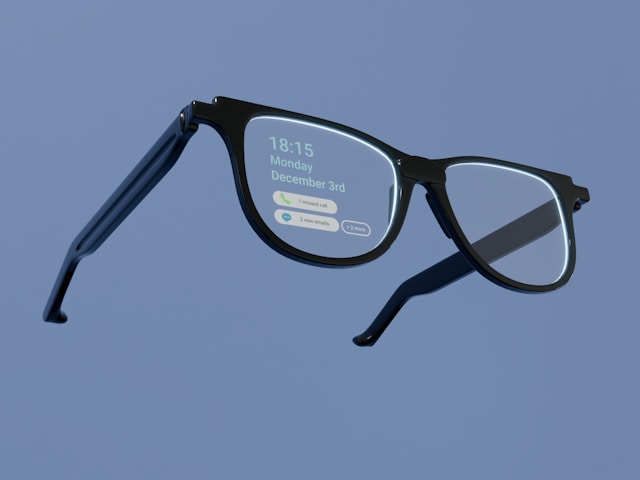
The system is straightforward. Using the built-in microphones and speakers, the glasses listen to one language and output translations in another, processed through the Meta app. At launch, it supports English, Spanish, French, and Italian, with downloadable language packs available for offline use.
The concept is compelling: instead of reaching for your phone, you simply ask a question or respond naturally, and the glasses deliver a translation instantly and discreetly.
What Reviewers Are Saying About Meta Glasses Live Translation
Pros
- Fast and accurate for short exchanges
- Great for travel basics like food or directions
- Hands-free, natural experience
- Offline translation packs available
Cons
- Limited to four languages
- Struggles with slang & idioms
- Background noise affects accuracy
- Voice activation inconsistent
Smooth for Basics
Reviewers found the glasses work well for short, everyday exchanges. The Verge noted they’re effective for simple conversations like ordering food or asking directions, with translations that are quick and accurate.
Where It Stumbles
According to The Verge and Android Authority, the glasses struggle with fast speech, slang, and idioms. Phrases like “no manches” in Mexican Spanish get translated literally. Background noise and whispers also reduce accuracy. WIRED added that written text is often paraphrased or summarized rather than translated word-for-word.
Reliability and Setup
Reviewers also mentioned that voice activation can be unreliable. In some cases, it’s easier to start translations from the app, since the system depends heavily on a stable connection.
How Meta Smart Glasses Translation Compares to Google Translate
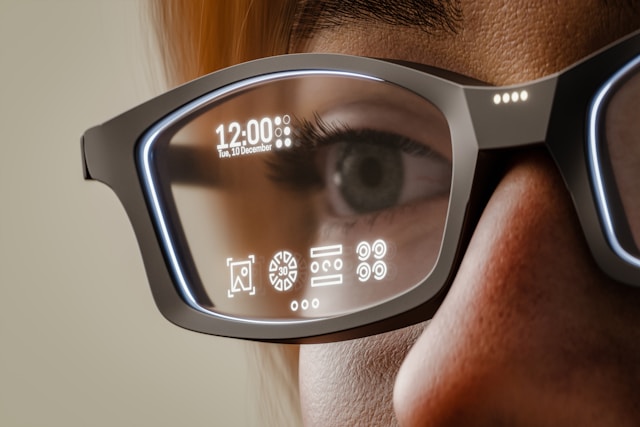
Any discussion of translation tech inevitably comes back to Google Translate, the long-standing leader in consumer translation technology.
- Coverage: Google supports over 200 languages, while Meta currently offers four.
- Features: Google handles text, speech, images, and live conversation modes.
- Meta’s distinction: The glasses deliver hands-free, natural translation, letting users communicate without looking at a phone.
As Android Authority put it, Google still has nothing to worry about — but Meta’s version offers a different kind of value: an experience that feels futuristic even if it isn’t as versatile.
Who It’s Best For
Reviewers generally agree that travelers will get the most benefit. For ordering food, navigating transport, or basic shopping abroad, the glasses provide a smoother experience than flipping through phrasebooks or juggling apps.
For casual users and early adopters, the translation feature offers a glimpse of how AI and wearables may soon become part of everyday communication. But for professionals, students, or anyone who requires precision and nuance, the technology isn’t ready to replace established tools.
The Bigger Picture
Despite limitations, most reviews acknowledge the wow factor. When the translations work, the experience feels like stepping into the future. The Verge described moments where conversations felt seamless, while Android Authority emphasized the novelty of doing this without a phone screen. Even WIRED, which was more critical of the written text translation, recognized the potential.
Meta has also signaled plans to expand language support and build on the integration of AI features like “Look and Ask”, which allows the glasses to provide visual context. If successful, these updates could push the glasses further toward the sci-fi dream of universal communication.
How to Live Translate Online without Meta Glasses
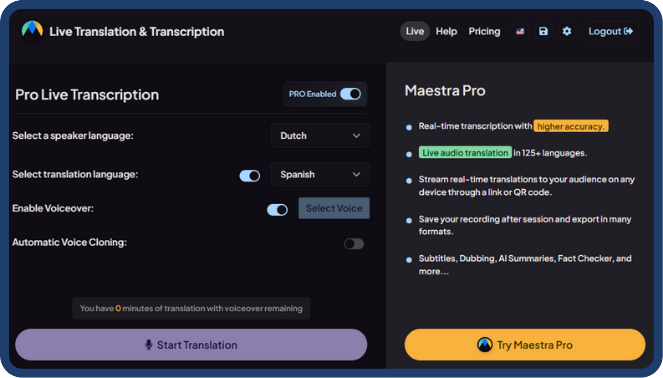
Even though the idea of wearing sci-fi looking glasses and talking in any language you want is pretty cool, if you haven't got the opportunity to own the meta glasses, there are other ways you can live translate your voice. Maestra Live is a pioneer in the real-time translation and transcription solutions with unique features such as live voice translation and real time voice cloning! All you need to do is access the tool, click a few buttons to configure language settings and start speaking!
Here is what Maestra's live translator offers:
- Live transcription
- Live captions
- Live dubbing and voice cloning!
- Multilingual session sharing
- Integrations with OBS, vMix, Zoom
- Being able to save sessions to edit them further into subtitles or voiceovers
Most advanced solutions require a subscription but every feature has a free trial for you to try!
Final Verdict
Meta smart glasses translation is a bold move toward bridging the language gap. According to reviewers, it works reliably for basic travel interactions and offers a futuristic, hands-free experience. However, it remains limited in language support, struggles with nuance, and depends on a stable connection.
It’s not a universal translator yet — but it’s closer than anything consumers have had before. For now, the technology gives us a taste of the future, one short conversation at a time.
And while it’s far from perfect, one thing is clear: it’s getting closer to sci-fi.
FAQ
Can Meta smart glasses translate languages?
Yes. Meta smart glasses now include a live translation feature that can translate conversations in real time. At launch, it supports English, Spanish, French, and Italian, with the ability to download language packs for offline use. You can speak naturally, and the glasses will process and deliver the translation through built-in speakers.
How to change language on Ray-Ban Meta glasses?
You can change the translation language using the Meta View app on your paired smartphone. Simply:
Open the Meta View app.
Go to the Translation settings.
Choose the language you want to translate to/from.
(Optional) Download language packs for offline translation.
You can also start translations by voice command, for example: “Hey Meta, translate Spanish to English.”
Can Meta translate text?
Yes, but with limitations. The glasses can identify and translate written text, such as signs, menus, or labels. However, as reviewers from WIRED pointed out, translations are often summarized or paraphrased rather than exact word-for-word. This makes it useful for quick context but less reliable if you need precise details.
How good is Ray-Ban Meta translation?
Reviewers agree it works well for short, everyday conversations like ordering food or asking for directions. The Verge described the translations as smooth for basic chats but noted issues with slang, idioms, fast speech, and noisy environments. Compared to Google Translate, it’s less accurate and covers fewer languages, but the hands-free experience makes it feel futuristic and convenient.
Which languages are supported on Meta smart glasses?
Currently, the glasses support English, Spanish, French, and Italian. More languages are expected in future updates, but as of now, the list is limited compared to apps like Google Translate.
Do Meta smart glasses work offline for translation?
Yes — if you download the language packs in advance using the Meta View app. Offline translation is especially helpful for travelers who may not always have internet access. Without the packs, the glasses rely on a stable connection to function.

